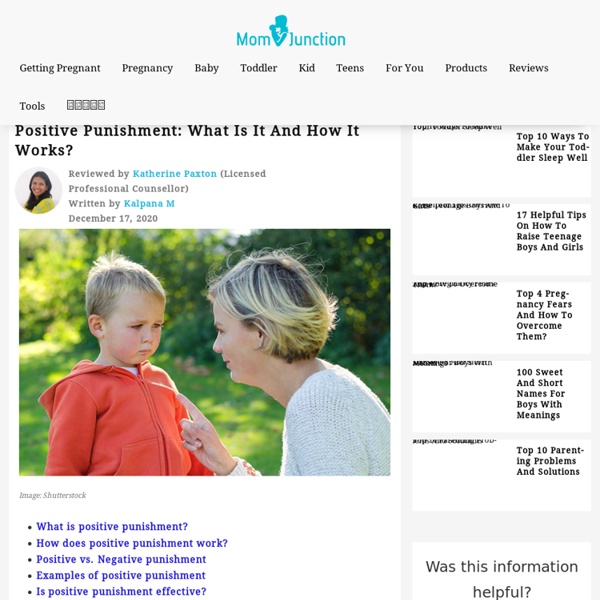10 Positive Punishment Techniques & Their Effect
By: Ashley Brown Updated February 11, 2021 Medically Reviewed By: Laura Angers As a parent, it is natural to wonder about the best way to teach your child right from wrong. Punishing them is no fun, but sometimes it has to be done if you want their behavior to change. Not everyone will agree on how you should punish your child, but some experts are convinced that positive punishment techniques are the best approach.
Punishment: 5 Negative Consequences
Today we are going to look further into the idea of using punishment and the 5 negative consequences that can follow. In my last article, I mentioned that the goal of discipline is to lead, guide, and direct kids towards pro-social behaviors. In contrast, punishment tells kids what to avoid and what not to do, or they will experience some form of pain! To better understand the negative consequences of punishment, let’s take a brief look at Joey’s story from last week’s article: It was a hot summer day, and Mom was excited to take her two young boys to the beach.
How Negative Punishment Works
Negative punishment is an important concept in B. F. Skinner's theory of operant conditioning.
What is Negative Punishment (Examples and Effectiveness)
In this article, we will review negative punishment, its definition, examples, and drawbacks. American psychologist B.F. Skinner developed the theory of operant conditioning, which stated that a person or animal’s behavior could be increased or decreased by adding or removing appropriate stimuli after the behavior is exhibited. The difference between classical conditioning and operant conditioning is that classical affects unconscious behavior, while operant affects conscious behavior. Within operant, punishment aims to reduce a behavior while reinforcement increase a behavior.
3 Examples of Positive Parenting in Practice
Do you like the idea of positive parenting but not sure how to put into practice in every day interactions? Like most families, in my home there are moments that are challenging. Sometimes what my children want, and I what I expect are not necessarily in agreement. Sticking to a positive approach to discipline, I am often able to defer power struggles, nagging and meltdowns and restore peace. Over the years I often found it helpful to hear from other parents, and to read examples on how to put positive parenting into practice. So here are three examples from my daily life with kids where I practice positive parenting:
Discipline Kids With Positive and Negative Consequences
When most parents think about consequences for kids, they usually envision negative consequences, like a time-out or taking away a video game. While negative consequences are instrumental in changing a child's behavior, positive consequences are also effective discipline tools. When used together, positive and negative consequences will change your child's behavior1 —as long as they are used consistently. Use positive consequences to reinforce good behavior and enforce negative consequences to discourage bad behavior. How Consequences Work
Reinforcement Vs. Punishment for Kids (And Examples)
As they grow, our children learn which behaviors are acceptable and which are not. They learn this through a process of cause and effect. Here’s an example of how this works: When you touch something hot, it burns and you take your hand away. Then, you remember it burns and you don’t touch the hot item again. This is cause and effect. The same principle applies to how you teach your child about their actions and behaviors.
Punishment vs reinforcement: Getting the behavior you want from your kids - FamilyToday
Some days, it feels like all we do as parents is discipline our children, but do we understand what discipline really means? The goal of disciplining children is not to punish them for bad behavior. Rather, discipline is a tool to get the behavior we want. Ultimately, children who receive discipline become disciplined in the way they think, act and speak.
Positive Reinforcement vs Positive Punishment for Kids: Types & Examples
Kids can certainly be a handful. Every parent knows that although their kids might be the greatest blessing of their lives, at some point or the other, their patience has been tested to the limit. And that is completely okay, because kids learn as they grow and parents grow into the role of great parents only by trial and error, since it is also their first time.



